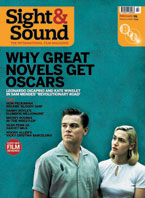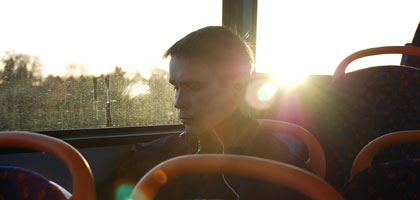Primary navigation


Duane Hopkins' first feature is an inventive, unclichéd example of British realism which shines a light into rarely explored social territory and the unexamined lives of its characters. By Jonathan Romney
It would be easy to stereotype Better Things, Duane Hopkins' debut feature, as an extreme example of British miserabilist realism. The film is severe in mood and the predominantly blue-grey tones of Lol Crawley's photography suggest an eternal Thursday afternoon of the soul. While its background of small-town drugs culture is hardly new to UK cinema, Hopkins' film depicts, or rather creates, a piece of the British social landscape that we have never quite seen before: a corner of the rural Cotswolds that appears to be twinned with the drab, doom-soaked expanses of Bruno Dumont's northern France.
Better Things is bookendedby a line, in voice-over, from the novel that Gail is reading: "This was real life, and real life was difficult at best." As with any work that dwells on life's difficulty, the critic is always tempted to plead that the tenor is finally optimistic despite all appearances - yet a too-positive view would traduce Hopkins' vision. Yes, intimations of hope are offered towards the end of Better Things, notably Gail's triumph over agoraphobia: she is last seen striding determinedly into the distance. However, the film closes on a composed shot of Rob after his overdose, stretched out like Henry Wallis' deathbed portrait of the poet Thomas Chatterton. Among the few overt philosophical statements in the film is Nan's remark, "This is a good life, as long as you don't weaken." But perhaps we shouldn't take too much consolation from that motto: the tragedy of Better Things is that people almost invariably weaken.
As a realist picture of small-town life, Better Things is observational to a semi-documentary degree, not least because of the casting of non-professionals, many of them young people with real-life drug experience. Its picture of drug use is equally free of clichés and of glamour: the local dealer is a no-nonsense, rather motherly young woman as opposed to British cinema's usual snarling geezers.
Unusually, Better Things juxtaposes the emotions of young and old and shows how alike they can be. This is most apparent when Mr Gladwin witnesses Larry raging on his phone at his ex-girlfriend; the older man has also been simmering (for years, it's implied) over a heartbreak, perhaps a betrayal on his wife's part. The film is notably unsentimental about its one source of wisdom, Gail's Nan. There is a cathartic moment in the film's first display of defiant will when the housebound Nan insists that Gail take her out: her expression of delight at the landscape, and a matching shotof windblown trees, briefly dispels the film's almost unbearable stasis. This moment of release comes just before Nan's death; perhaps Gail learns from it in time. Still, this is an unsentimental picture of age passing on knowledge to youth and the austere tone endures.
Throughout the film, Hopkins manages an intensely realised orchestration of motion and stillness, the latter being predominant. Characters often seem to move in slow motion, in the distorted temporality of heroin use. A key image of Jon' scar racing through the countryside at night with shots through the windscreen offers a picture of going nowhere fast. As in the techno music that can occasionally be heard, there is little difference between perpetual forward motion and absolute stasis.
While very much an individual stylist, Hopkins shows the same contemplative attention to small, workaday details as his contemporaries Lynne Ramsay and Andrea Arnold. This is as meticulously and overtly edited a film as any Hollywood drama: Hopkins is not one for the glumly contemplative long take, itself increasingly an art-cinema cliché. Rather, he and editor Chris Barwell offer extended chains of discrete images for us to order associatively, as we would with images in poetry, rather than to construct narrative information.
Indeed, Better Things requires the viewer to do more connective work than just about any other recent British film. Hopkins' style establishes itself in a quietly striking pre-credits sequence, which begins with 28 discrete shots of even length, so uniformly static that at first they might be mistaken for a sequence of photographic stills.
A series of shots of Gail in her room, framed by images from the surrounding landscape (trees on the horizon, rows of nondescript suburban-style houses); then images from the scene of Tess's overdose, including close-ups of heroin user's gear, of the needle stuck in her arm, of her frozen features; the name 'TESS' written in flowers on her grave, and Rob standing holding a bouquet. Movement comes at last in two shots, as Rob turns his head, in a third as a tear rolls down his cheek; then stasis returns in the image of a closed church door.
While at moments this approach could be accused of verging on mannerism, Hopkins succeeds in evoking a world that is self-enclosed yet fragmented, ruled by emotional dissociation above all - between people, and between indviduals and their own feelings. Gail's opening voice-over doesn't seem to bring us any further into her personal world, but rather establishes the disconnection between herself, the world she gazes out on, and the world of emotions and disappointments she reads about in novels.
Better Things is as closely tunedto the emotional meaning of objects and spaces as Ramsay's Ratcatcher, or Terence Davies'searly autobiographical features. Threaded through the film are shots through windows and doorways, framed empty spaces suggesting habitats as haunted,yet as mundane, as the interiors of painter Vilhelm Hammershøi; people often disappear into blurs behind the frosted-glass window-doors typical of British suburbia. There is also a spiritual strand in the imagery: the remembered/hallucinated scenes between Rob and his lost Tess are shot in brilliant white light; a shot of the white-haired Nan against a pale wall suggests a soul already melting into abstraction; a later close-up after her death is faintly stretched, echoing the weightless distortions of Sokurov's Mother and Son (1997).
The film is just asmeticulous in its sonic palette, designed by Douglas MacDougall, although the dislocations can sometimes seem over-deliberate: the sudden disruptive noise of a zip fastener, or the sound of a car's motor dropping out so that we can hear its passengers' dialogue. Still, this is one of those rare films that signifies aurally as much as visually, and the use of music is particularly eloquent - what appears to release Mr Gladwin from his emotional prison is his solitary listening to an obscure Burt Bacharach number, the Cryin' Shames' 'Please Stay', in which a churchy organ underpins the theme of hoping against hope for reconciliation.
The casting is composed almost entirely of non-professionals, the only familiar face being Freddie Cunliffe, seen in Tim Roth's 1998 drama The War Zone. The younger players generally give low-key performances that are as much about simply displaying their own muted, vulnerable presences as they are about acting as such; Kurt Taylor and Megan Palmer, as the love-crossed Rachel and Larry, are unusual in conveying the furious, tormented energies we expect in films about youth.
The cast appear to be playing roles very close to themselves. The Gladwins are played by a real-life couple, Betty and Frank Bench, while many of the young actors have been drug users, including Che Corr and Tara Ballard, a former couple in real life, who play lovers David and Sarah. The film's ending is doubly painful given that Liam McIlfatrick, who plays Rob, died of double pneumonia in September 2008, aged 24, weakened by his past drug abuse and by years of living rough. (He had used heroin for six years but had been clean for two when Hopkins cast him.) Seeing Better Things in that knowledge makes the film's title all the more bitterly poignant, but also brings additional urgency to the sliver of hope that it offers.